This is Part II of my post describing my “shotgun approach” to overcoming chronic early-morning awakening insomnia. In Part I, I discussed sleep hygiene, my bedtime routine, yoga, the work-recovery balance, sensory deprivation and naps. In Part II, I’ll look at tracking sleep, light therapy, weight and melatonin supplementation.
Tracking sleep
“If you can measure it, you can manage it.”
This saying may have its origins in business, but athletes should take note. These days there is a slew of sleep tracking apps and gizmos. I prefer to keep it simple. Every morning, I record my wake up time and rate my sleep quality on a 5 point scale in my tracking spreadsheet. This simple exercise helps me identify the factors affecting my sleep. For example, I’ve recognized that high intensity exercise in the evening is asking for trouble, but a little yoga before bed is very helpful.Having a record of my sleep also helps me adapt my training load. One mediocre night sleep is probably business as usual, but I’ve learned that a string of poor sleeps signals that it’s time to dial back my training. Read more about my approach to tracking: Monitoring and Managing Stress: A Simple System for Athletes.
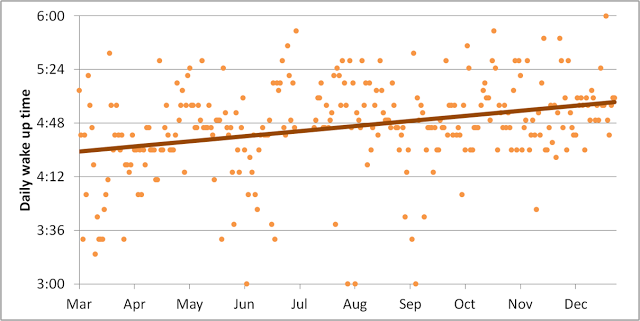
Light therapy
Bright light therapy has well-established benefits in the treatment of some sleep, mood and seasonal affective disorders (e.g., 1, 2, 3, 4, 5). For sleep disorders, the idea is that regular exposure to bright light in the evening or morning can help reset your body’s biological clock, i.e. your circadian rhythm, daily processes that govern your sleep cycle.
I tried the Philips goLITE Blu, a small lamp that emits blue visible spectrum (UV-free) light. As per the instructions, I aimed to get a 15-45 minute dose in the morning around sunrise during the dark winter months. Unfortunately, this often proved to be impractical since I’m usually out training at this time. The power cord also made it inconvenient to move around the house (there is a more expensive battery-operated model). As a result, I only used the light sporadically.
I don’t think that I gave light therapy a good enough shot to comment on it’s efficacy. I plan to start using it again this month.
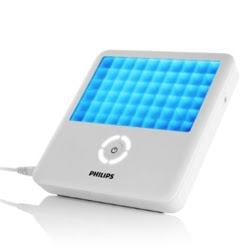
Skinny & sleepless
At the height of my insomnia, I weighed under 140 lbs (63.5 kg) at 6″ (183 cm) tall. Body weight and composition have some pretty profound effects on hormonal and metabolic health, which in turn influence and are influenced by sleep. There’s a lot of evidence, mostly anecdotal but some scientific, that being underweight can be associated with sleep impairment (e.g. 1, 2, 3, 4). Going from under 140 lbs to about 150 lbs, I noticed a steady increase in the quality and amount of my sleep. But remember, correlation ≠ causation and even the direction of causation is unclear: was I able to gain lean body mass because I was sleeping better or vice versa? Or maybe the two are interrelated, i.e. a feedback loop. Life would be simpler if I never studied science!
Read more about my experience gaining weight: Fatter & Faster? Finding My Racing Weight.
Melatonin supplementation
Melatonin is a natural hormone that is involved in governing the body’s circadian rhythm. It is not like a conventional sleeping pill, nor should it be viewed as a long-term solution for coping with sleep disorders. It is probably best viewed as a “darkness signaler”, or a short-term method to reset your body’s clock. It is available over the counter in Canada, the US and many other countries.
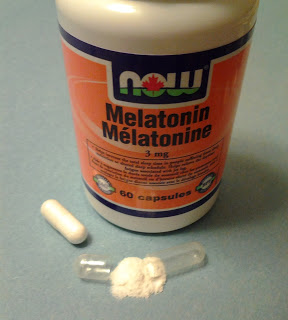
Research on the efficacy of melatonin in treating various sleep disorders has shown mixed results, and there are some indications that long-term use can lead to increased tolerance and dependency. Nevertheless, a recent meta-analysis showed promising results for the treatment of sleep disorders. While individual responses vary, I found it to be an effective crutch while I addressed the primary causes of my morning insomnia. And in case you’re wondering, there is no evidence that melatonin enhances athletic performance (besides the indirect but huge benefits of improved sleep).
I like to have a good understanding of everything I put into my body, especially when it comes from a pill bottle. The fact that melatonin is “natural” changes nothing. Artificially manipulating your hormonal balance, even in a very minor way, is something to approach with extreme caution.
I was reluctant to resort to chemical assistance, but after exploring other options, I decided to conduct my very own N=1 drug trial. Over the course of 80 days, I varied my bedtime dose from zero to ~2 mg and observed my wake-up time the following morning. The results show a small but significant positive correlation. Taking melatonin didn’t guarantee a good night’s sleep, but it delayed my wake-up time by an average of >20 minutes. I have also observed that melatonin can improve my quality of sleep, although this effect is pretty well impossible to quantify without visiting a sleep lab.
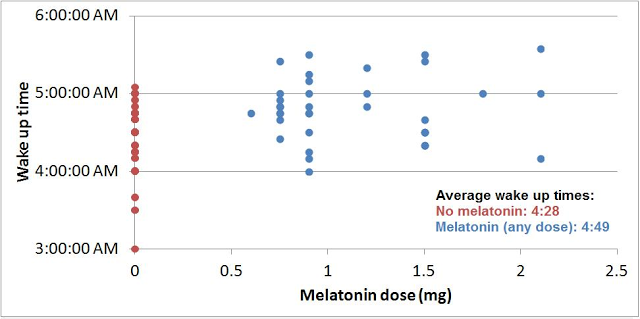
A better experiment would have used randomized doses. As it was, I tended to take more melatonin when I was feeling more wound up and less likely to sleep well, which probably skewed the results. Correcting for this effect likely would have led to an even stronger positive correlation. I was also simultaneously using the other strategies outlined above and not controlling for them, make this all-in-all a pretty shoddy experiment.
Another interesting observation is that the exact dose doesn’t seem to matter; there were similar benefits across the range of doses, all of which were low (a typical capsule contains 3-5 mg). Recommended doses for melatonin are the subject of debate, ranging from minute amounts to 20+ mg. Since this trial, I have found that doses as low as ~0.2 mg (one fifteenth of a typical pill) are quite effective.
Even now that I have declared victory over insomnia, I still occasionally take melatonin. I find it useful as a temporary aid to cope with peak training periods or a disrupted schedule (e.g. travel). Perhaps the placebo effect is at work, but most of my best pre-race sleeps have been melatonin-assisted!
